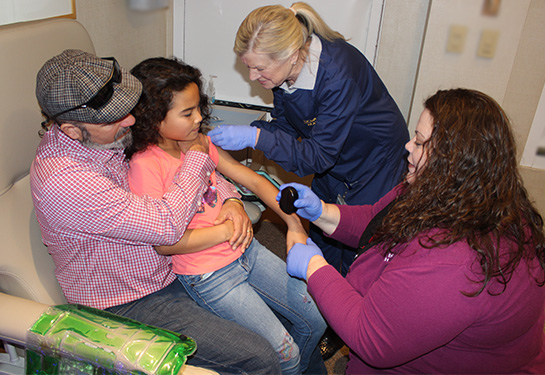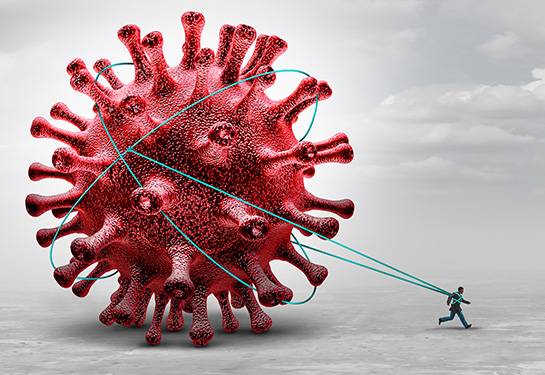How at-home rapid COVID tests can help families stay safe during Omicron (video)
UC Davis expert shares tips about when to test, caring for kids with COVID-19 and isolation versus quarantine
At-home COVID-19 antigen tests have been flying off store shelves as more people are being exposed to the more contagious Omicron variant. UC Davis pediatrician Ivan Marquez answers questions about how this simple form of self-testing can be another valuable tool to help families stay safe during the pandemic.
How does Omicron compare to the other COVID-19 variants that we have seen?
The biggest difference is that Omicron has an increased transmissibility and a greater ability to evade the immune system. It’s more infectious than other COVID-19 variants that we have seen, and it is more likely to cause symptoms even if you have been exposed in the past, if you’ve had an infection in the past or if you have been vaccinated. Fortunately we have seen that you are less likely to have symptoms that require hospitalization if you have been vaccinated.
We have also seen that children have been getting infected at increasing rates as community transmission has also skyrocketed with the Omicron surge. We know this is particularly the case for children under 5 years of age, who do not yet qualify for the COVID vaccine.
How can rapid antigen COVID tests help us during this Omicron surge?
The at-home COVID tests, also known as rapid antigen tests, are a great tool to provide surveillance for infections and try to prevent outbreaks of infections. They are especially useful because they give you quick results. You can have results quickly before going back to school or going back to work. I recommend using them to provide surveillance. Tests can be purchased without a prescription and are available at pharmacies and stores. Brands include BinaxNOW and iHealth. Sign up for four free COVID test kits through the federal government.
If you have been exposed to someone with a known COVID infection or if you are having symptoms, at-home tests can provide a really good sense of whether or not you have an infection so you can plan your next steps accordingly. Watch this video on tips for using a rapid antigen test.
These tests are pretty reliable, but it doesn’t mean that they are perfect.
If you have symptoms and test negative, you still might have COVID-19 and should isolate away from others.
If you have symptoms and you test positive, I would treat it as a positive result. You can always request a diagnostic or PCR test from your physician to confirm that result. If you test positive, plan on isolating for at least five days, as currently recommended by the Centers for Disease Control and Prevention.
After five days from when the first symptom appeared or from the day of the positive test result, you can end your isolation only if you have a negative at-home antigen test, your symptoms have improved and you have been fever-free (without taking a fever-reducing medicine) for 24 hours.
What is quarantining versus isolation?
Quarantining is a preventative measure when you have had exposure to a positive contact, but don’t know if you are positive. The CDC recommends that if you are unvaccinated and have not tested positive for COVID-19 within the past 90 days, you should stay home and away from others for at least five days, if they have come in contact with someone who has COVID-19.
Isolation is when you have a known positive COVID infection, and you are separating yourself from others who you could catch the virus. See the CDC’s current guidelines for quarantining and isolation.
What should parents do if their child tests positive?
Make sure your child is isolating if they test positive. They should not go to school or to public places. They should stay home, even if they are symptom-free because they can still spread the virus.
If they have symptoms, ensure that your child stays hydrated, and that they are breathing comfortably. If they are having any fevers or discomfort, it’s OK to give them Tylenol or Motrin. Follow the dosing on the back of the box and generally try to keep them comfortable.
Other signs you should look out for:
- If they are throwing up and not able to keep anything down
- If they are not able to drink enough to stay hydrated
- If they are urinating less than their normal amount
- If they are having any trouble breathing
Then call their pediatrician or take them to an emergency department if you are worried.
If you are a parent of a child who tests positive, I would also recommend testing to see if you or any other members of your household test positive.
What should parents know about the COVID-19 vaccine?
Even though COVID continues to mutate with different variants, and even though health and safety guidelines change, what we have seen consistently throughout this pandemic is that vaccines are one of our most effective tools at preventing the spread of COVID infection, preventing hospitalizations and death. The COVID-19 vaccine is currently available for those ages 5 and older.
We may never live in a world without COVID, but we can live in a world where COVID doesn’t disrupt our lives the way that it has. The only way we will get to that point is to get enough of the population vaccinated and protected. If you haven’t been vaccinated, it’s never too late. If you have been vaccinated and are eligible for a booster, that is one of the most effective ways to prevent severe infections, especially with variants such as Omicron or the next variant that comes, as well.
Learn more about scheduling a COVID-19 vaccine at UC Davis Health or through the state of California’s vaccine site.
Related links
10 things to know about the very contagious Omicron variant
UC Davis Medical Center sets record for COVID 19 patients amid Omicron surge
Why is the Omicron variant more infectious for children than previous variants – Fox 40



